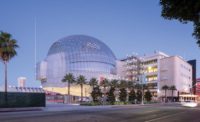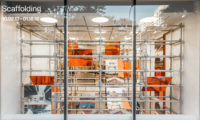Today, the Academy Museum of Motion Pictures introduced preliminary programming plans for its future location in Los Angeles’ Miracle Mile district. The museum, designed by Renzo Piano Building Workshop, will be housed within the 1939 May Company Building on Wilshire Boulevard and a new adjacent structure—a 140-foot-tall glass and steel orb accommodating a 1,000-seat theater and large terrace overlooking the Hollywood hills. Construction on the project began in 2015.
According to Kerry Brougher, director of the Academy Museum of Motion Pictures, the concepts for the exhibition spaces were developed from a filmmaker’s perspective, as opposed to a “high-altitude film history look at cinema.”
“I think the fact that the Academy is part of the project makes it take on a different characterization than it might if it were a film museum in Milan or Paris,” he tells RECORD.
Once renovated, the six-story May Company Building will include two floors of permanent exhibition space, which will survey the evolution of movie making through large-scale screens, costumes, props, sound installations, and other items such as screenplay manuscripts and photographs. Another level will be dedicated to rotating exhibitions.
Central to the museum’s programming is the creation of immersive environments. “It’s important that the exhibitions are not just a bunch of objects in a gallery space,” says Brougher. “I wanted those objects to be brought back to life by using the moving image with them.”
To accommodate such a variegated assortment of display items and media, the architects designed the gallery spaces for maximum flexibility.
The May Company Building will be connected to the spherical structure via a series of glass bridges. The main theater within the dome will be equipped for the projection of 35mm, 70mm, and nitrate prints, enabling visitors to view films in their original state. A smaller theater will be located on the lower level of the 300,000 square-foot campus.
Of the $388 million project, which is slated for completion in 2019, Brougher says: “I hope after people go through the museum that they take away with them an understanding that cinema is the great art form of the 20th and 21st centuries—and that it’s an art form that takes collaboration.”











Post a comment to this article
Report Abusive Comment